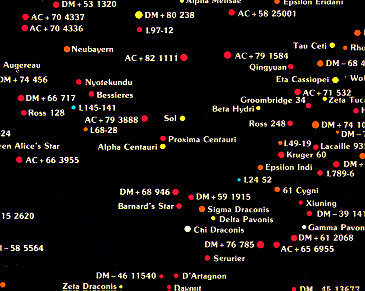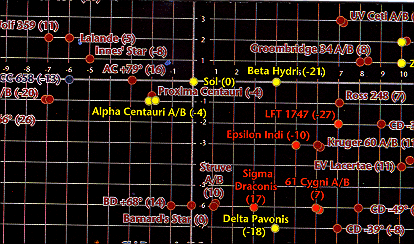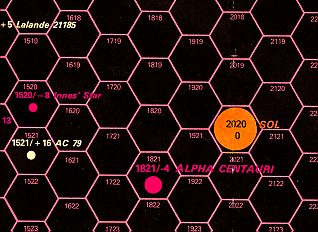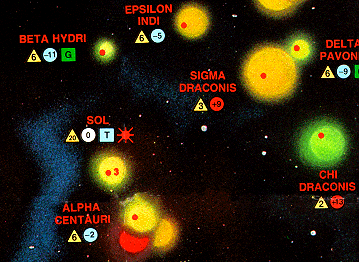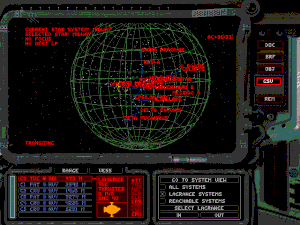Books
The list is organized alphabetically by the author's (or authors') last name where possible.
A-D
- How to Build a Planet
- Poul Anderson, SFWA HANDBOOK 1976. Poul Anderson and Stephen Gillett did an update of "How to Build a Planet". It's #19 in the "Writer's Chapbook Series" available from Pulphouse Press (Box 1227, Eugene, OR 97440).
- How to Build a Future
- John Barnes, ANALOG magazine March 1990, later collected in Writing Science Fiction and Fantasy, St. Martin's Press 1991. It was later updated and is now #18 in the "Writer's Chapbook Series" available from Pulphouse Press (Box 1227, Eugene, OR 97440).
- Across the Sea of Suns
- Gregory Benford. This includes an isometric map of the local stellar area. Thanks to Randy Wolfmeyer for bringing this to my attention.
- Space Travel: A writer's guide to the science of interplanetary and interstellar travel
- Ben Bova with Anthony R. Lewi, Writer's Digest Books, 1997, ISBN 0-89879-747-0. Part of the Science Fiction Writing Series, it has 14 chapters dealing with everything from space industries and star systems to industrial uses of space. It's a good companion to Gillette's World Building writer's guide...(thanks to E.R. Uber for bringing this to my attention)
- How To Build A Habitable Planet
- Wallace Broecker, Eldigio Press, 1987, This book is an outgrowth of an undergraduate course taught by the author at Columbia College and Barnard College.
- The 11 Billion Dollar Bottle of Wine, the possibilities of interstellar trade
- Greg Costikyan, ARES magazine #12, January 1982
- Interstellar travel : a review for astronomers.
- I. A. Crawford, Quarterly. Journal. Roy. Astron. Soc., 31, 377 (1990).
- The Zeta Reticuli Incident
- Terrence Dickenson, AstroMedia corp. 1976. A debunking of a popular UFO myth, but includes a list of the closest sunlike stars and other astronomical discussions. Please note that the link above does not include any of the diagrams. This highly recommended publication is available in hard copy from Stanton Friedman or available on the web .
- Habitable Planets for Man
- Stephen H. Dole, 1964. The standard text on what factors allow a human-habitable planet. The result of a RAND study. Check the RAND site to order the book online, do an author search for "Dole". (Be warned, as the book is out of print, what you will receive is a bound photocopy) There was a later popularized version of this book by Issac Asimov, which omits the equations, alas.
- IN: Methods of communication - Message content, search strategy, interstellar travel
- F. Drake, Interstellar communication: Scientific perspectives. (A75-25701 10-88) Boston, Houghton Mifflin Co., 1974, p. 118-139. An examination is conducted of the basic concepts upon which the search for extraterrestrial signals is built. Problems regarding the detection of other civilizations are related to the probable distance to the nearest detectable or communicative civilization and to the most successful detection method.
E-F
- This Quarter of the Universe is Ours!, a handbook for building three dimensional starmaps
- J. Richard Filisky, Theta Enterprises, Richardson Texas, 1976. Gives details about building 3-D star maps with string and beads. Includes the Gliese 2.0 catalog converted into x,y,z co-ords.
- The Guide to the Galaxy
- Henbest & Couper, Cambridge 1994, ISBN 0-521-45882-X. A most marvelous book! Includes detailed maps of our galaxy's spiral arm structure and location of various nebulas. Some of the maps are available here.
- 3-D Star Maps of Nearby Stars, the Pleiades, Orion, and the Local Group: How to Make Stellariums, a Scale Model of the Solar System, and a Brief Explanation About Interstellar Travel
- Booklocker 2003. Gives instructions on how to construct museum quality 3-D starmap displays and related items. (Out of print)
- A Planet Dweller's Dreams
- Martyn J. Fogg, ANALOG magazine October 1992. Martyn Fogg has spent almost a decade investigating planetary systems, concentrating his recent efforts on the study of planetary habitability and terraforming. He is internationally recognized as Britain's principal researcher on terraforming, publishing numerous scientific articles and papers on the topic. Fogg has also been a consultant to Time-Life and BBC television and radio, and has given numerous lectures and presentations worldwide on terraforming.
- An Estimate of the Prevalence of Biocompatible and Habitable Planets
- Martyn J. Fogg, Journal of The British Interplanetary Society Vol. 45, pp.3-12, 1992. This article describes a Monte Carlo computer model of extra-solar planetary formation and evolution. It estimates 1 biocompatable planet per 39 stars, and a subset of 1 habitable planet per 413 stars. It also has a marvelous bibliography.
- Temporal Aspects of the Interaction among the First Galactic Civilizations: The "Interdict hypothesis"
- Martyn J. Fogg, ICARUS 69, 370-384 (1987). The article describes a computer simulation of the initial expansion and interaction of the first galactic civilizations. It has implications re: Fermi's Paradox. A facinating analysis, and an excellent bibliography.
- Terraforming: Engineering Planetary Environments
- Martyn J. Fogg, Society of Automotive Engineers, 400 Commonwealth Dr., Warrendale, PA 15096-0001. Ph. 412-776-4841.According to Stephen Gillett and quite a few others, this is the definitive new book on terraforming. Read the review.
- Timemaster
- Robert L. Forward, TOR Books 1992, ISBN 0-812-51644-3. A nifty SF novel by one of the hardest "hard-science" SF writers, it includes an appendix in the back with some 3-D starmaps.
- Flinx in Flux
- Alan Dean Foster, Del Rey Books 1988, ISBN 0-345-34363-8. Another one of the marvelous "Flinx" novels, this one includes a starmap. Most of the stars are imaginary, but the placement of the various nebulae (Triffid, Lagoon, Cygnus X-1, etc.) are accurate. At least they match the maps in THE GUIDE TO THE GALAXY
G-K
- World Tamers Handbook
- Game Designers Workshop : GDW 0311 ( Out of Print ) ISBN 1-55878-168-4. A supplement to the Traveller role playing game, this book contains lots of information for worldbuilders. Thanks to Daniel Cleyne for this reference!
- Carbonosis: Organic Desiccation and the Fermi Paradox
- Stephen L. Gillett, ANALOG magazine March 1993.
- On Building an Earth-Like Planet
- Stephen L. Gillett, ANALOG magazine July 1989.
- World Building: A writer's guide to constructing star systems and life-supporting planets
- Stephen L. Gillett, Writer's Digest Books, ISBN # 0-89879-707-1. This should be on the book shelf of every world builder. I believe that it is the textbook for World Building Class at Cal State. Mr. Gillett has a Ph.D in geology, is a frequent contributer of science fact articles to Analog magazine, and has conducted worldbuilding seninars at Contact. The book has all the equations and facts you need to get started. (well, he did neglect to supply the value for the Stefan-Boltzmann constant, needed for one of the equations, but you don't need that equation for worldbuilding anyway. It's 5.6697e-8 W/m2/K, if you simply must know. This and other constants are available in Space FAQ #4)
- Friday
- Robert Heinlein, Ballantine Books 1982, ISBN 0-345-30988-X. This novel includes a small 3-D starmap of the colonized stars, along with assorted stellar information about them.
- GURPS: Space
- Steve Jackson Games. This is technically a sourcebook for a role-playing game, but it contains lots of information useful for anybody trying to design a solar system/interstellar civilization/galactic cluster.
- Proximity Zero, A Writer's Guide to the Nearest 200 Stars (A 40-Lightyear Radius) [2nd Edition]
- Terry Kepner, ISBN # 0-926895-04-4. This is a most valuable book, just chock-full of critical information. This has a 3-d starmap of stars within 40 light years of earth, as a series of six light year thick "slices" of the 40 light year sphere. The map is based on the Royal Greenwich Observatory Catalog of Stars Within 25 Parsecs of the Sun. And it is in galactic co-ordinates to boot. Some stars have extra information listed, like the separation between binaries in Astronomical Units, and other goodies (I didn't know that Arcturus was a metal poor Population II star just zipping through the solar neighborhood!). More importantly, the ecosphere of every star is listed! (Ecosphere: that range of distances within which an earthlike planet will be neither too hot nor too cold.) The Second Edition has Distance Tables that give the distances between all stars listed, not just the distance from the Sun. No more math required! It also has useful commentary on which stars are more likely to have human-habitable planets and why. Available from the author for $19.95 + $3.00 Priority Mail return postage ($5 outside US): Terry Kepner, PO Box 428, Petersborough, NH 03458
- World Builder: A Modest Program for Designing Strange New Worlds
- Stephen Kimmel, CREATIVE COMPUTING June 1983.
L-O
- The Fermi Paradox: An Approach Based on Percolation Theory
- Dr. Geoffrey A. Landis. A thought provoking hypothesis explaining the so called "Fermi Paradox".
- Starflight Handbook
- Eugene F Mallove and Gregory L. Matloff. Daniel Lane suggested this book to me. This is another book that belongs on the shelf of every serious starflight fan. It not only includes a list of nearby stars in the appendix, but it has tons of nifty equations for everything from mass-ratios of chemical rockets to calculations for relativistic acceleration!
- Star Trek Star Charts: The Complete Atlas of Star Trek
- by Geoffrey Mandel, Doug Drexler, Geoffrey Mandell. ISBN: 0743437705. A working atlas of the Star Trek galaxy.
- Sci Fi - Arizona ASTROGATOR'S MANUAL Practical Astrogation For Science Fiction Writers
- by Michael McCollum. This excellent manual belongs on the shelf of every serious 3-D starmapper. Written by hard SF author Michael McCollum (author of ANTARES DAWN, ANTARES PASSAGE, LIFE PROBE, and my personal favorite PROCYON'S PROMISE) this work shows the local stars in a 50 by 50 by 50 light-year cube centered on Sol. Displayed as a series of five light year thick slices, it also includes the star data in tabular form, notes on spectral types, constellation names, and the Greek alphabet. There is also the The Art of Science Fiction, Volume 1; it contains the article "Practical Astrogation", which contains much of the information of this web site, but written much more lucidly.
- Sci Fi - Arizona ASTROGATOR'S MANUAL - EXPANDED EDITION 3500 Stars as Viewed From Polaris
- by Michael McCollum. New and improved! This one blows the original right out of the water. At $14.95 for the PDF version and $29.95 for the hardcover, it is a steal! While the original only covers 300 stars in a 50 light year cube, this new version has 3500 stars in a 150 light year cube! Based on the Gliese data, it has maps of 50x50x20 light year "quadrants" in equitorial projection. Stars are displayed in their x,y postion, labeled with the name, index number, spectral class and z co-ord. Tables in the appendix have additional infomation. Like the original, it also includes a chapter on basic astronomy, intended to get a beginner science fiction writer up to speed. While you are there, do check out their on-line bookstore of astronomical texts.
- 3-D Star Maps
- by Richard Monkhouse and John Cox, Swallow Publishing Ltd, London, UK 1989. ISBN 0-06-016131-0. Brian Fenerty got me a copy of this book. It contains Red-Blue analglypic images of the night sky, with stars set at their relative distances.
- The Writer's Guide to Creating a Science Fiction Universe
- George Ochoa and Jeffrey Osier, Writer's Digest Books. I haven't seen this book, but James Rau says that it a great introduction to basic astronomy and worldbuilding concepts.
- Is Interstellar Travel Possible?
- E.J. Opik, Irish Astronomical Journal, vol. 6(8), p. 299, 1964
- The Astronomical Companion
- Guy Ottewell, 18th printing, with revisions 2002. ISBN 0-934546-01-0 Scientific American says "The three dimensions are vivid; it is not a page we are inspecting, but a spacial volume...an atlas of the glowing furniture of space...The entire work is a tour de force, the product of understanding and taste." I must agree, this is a stunning work. It includes a series of 30 ten-inch diagrams showing spheres of space from the moon's orbit to the limits of the observable universe. The near star map is really useful. And the additional astronomical information makes this a valuable reference work.
P-S
- Interstellar travel and communication bibliography - 1986 update.
- Zbigniew Paptrony, Juergen Lehmann, and John Prytz, British Interplanetary Society, Journal (Interstellar Studies) (ISSN 0007-084X), vol. 40, Aug. 1987, p.353-364.
- The Planetary Engineering Bibliography
- Great online list of articles and books about terraforming and related topics.
- Our Nearest Celestial Neighbors
- Josua Roth and Roger W. Sinnot, Sky & Telescope magazine October 1996. Nice article about how difficult it is to determine the nearest stars, and includes a wondeful table of the 25 nearest stars. The stars are for the most part from the Gliese-Jahreiss catalog, but the table has been updated with the latest distance data from the Research Consortium on Nearby Stars.
- On Designing an Interstellar Starship
- Milton Rothman, ISAAC ASIMOV'S SCIENCE FICTION MAGAZINE, September 1980.
- On Faster-Than-Light Paradoxes
- Milton Rothman, ISAAC ASIMOV'S SCIENCE FICTION MAGAZINE, May 1980.
- The Economics of Interstellar Commerce
- Warren Salomon, ANALOG magazine, May 1989. A very well-reasoned analysis on possible ways that interstellar trade can establish itself. It will repay careful study. This essay is reprinted in ISLANDS IN THE SKY, a collection of Analog articles available from Amazon.com.
- The Wealth of Galaxies
- Warren Salomon, ANALOG magazine, December 1989 guest editorial. A follow-up to THE ECONOMIES OF INTERSTELLAR COMMERCE.
- The Millenial Project: Colonizing the Galaxy in 8 Easy Steps
- Marshall T. Savage. A must read for people interested in the mechanisms for interstellar colonization.
- Aliens and Alien Societies
- Stanley Schmidt, Writer's Digest Press, 1996.
- On the Creation of Star Maps
- Christopher S. Spilman, THE SPACE GAMER magazine (unknown date). Mostly notes about determining the probable amount of error inherent in the star data.
- Which Highway to the Stars?
- James Strong, SPACEFLIGHT magazine, April 1970. Article about probable interstellar exploration routes.
T-Z
- Pandora: Rational World Creation
- Arlen P. Walker, DIFFERENT WORLDS magazine, Issue 29, June 1983. Notes about creating a logical planet.
- Programming Project: New Perspectives on Nearby Stars
- Bruce Webster, in BYTE Magazine, issue July 1985. 3-D starmap program for the Macintosh.
- Habitable moons around extrasolar gas giants
- D.M. Williams, J.F. Kastings and R.A. Wade, Nature, 385, 234-235 (1997). Until now, no serious scientists have examined this possibility!
- Echoes of Earth
- Sean Williams & Shane Dix, Ace Books, 2002. ISBN 0441008925. A well written multidimentional hard-science novel. The novelists actually got some assistance in developing the book's background from this very website.
- On the question of interstellar travel.
- J. H. Wolfe, IN: The search for extraterrestrial life: Recent developments; Proceedings of the Symposium, Boston, MA, June 18-21, 1984 (A86-38126 17-88). Dordrecht, D. Reidel Publishing Co., 1985, p. 449-454. Arguments are presented which show that motives for interstellar travel by advanced technological civilizations based on an extrapolation of earth's history may be quite invalid. In addition, it is proposed that interstellar travel is so enormously expensive and perhaps so hazardous, that advanced civilizations do not engage in such practices because of the ease of information transfer via interstellar communication.
Games
There are several boardgames that come with 3-d starmaps, most of which are unfortunately out of print. They are all good, though my favorite is the one included with Universe.
Here is a list of dealers who specialize in out-of-print games. Just in case you simply have to obtain one of them. These games also occasionally appear in EBay auctions.
I am working on commercial maps that are available at my Cafe Press web store.
I have an idea that most of these maps have "trap streets" and "fictitious entries" in them. That is one or more of the stars have a made-up name, a deliberately incorrect location, or are totally fictitious.
Think about it, say you are a company that went to a lot of trouble to make one of these maps. Wouldn't you be irritated if a rival just copied your map? Wouldn't you be even more irritated if they got away with it because in court their lawyer argued that given the same data the same map would be produced?
Now, imagine how satisfying it would be to be able to point out that your rival's map had Gonzola's Star, just like yours? Caught, red-handed!
I understand that this is common in the Dictionary and Encyclopedia industry, adding bogus entries to catch thieves. Or so I gathered by reading a Fred Saberhagen Bezerker story called "The Annihilation of Angkor Apeiron".
Some of the names I've encountered that look suspicious to me include "The Flying Star", "Qingyuan", "Haifeng", and "Queen Alice's Star".
A gentleman named Bob pointed out that "The Flying Star" is actually a name given to the star 61 Cygni by Giuseppe Piazzi in 1792. However, there is still something screwy with the map (the SPI Universe map), since the star given that label was BD+36°2219.
List
- Traveller 2300AD, GDW.
- Bug Hunters / Amazing Engine RPG supplement, GDW.
- The Company War, GDW.
- Mayfair Games Inc. A wargame based on C.J. Cherryh's SF novels, set in the universe of Downbelow Station. Out of print
- Explored Space, GDW.
- Nightshift Games, a division of Crunchy Frog Enterprises. This is an expansion book for the game Voidstriker. Really well done starship combat game, and the starmap data was created with assistance from *me*! (In the game, stars are connected by jumplines. A jumpline connects two stars who are closer than distance X where X depends on the masses of the stars in question. The mass of the Sun=1. So if the mass of star 1 was M1 and the mass of star 2 was M2, then x = 7 + ((M1+M2)/2) in light years. The game creator was understandably quite happy that I could write a program to digest the Gliese catalog and calculate all the jumplines for him).
- FTL:2448
- Tri Tac Systems. A well done role playing game set in the future. Its firearm combat system is one of the most accurate. But more to the point, it has a reasonably accurate starmap.
- Starforce Alpha Centauri, SPI.
- A classic wargame, played on a 3-d map of all the stars within a 20 light year radius of the Sun. It's a classic game, find a copy if you can. Map is a hexgrid with each hex equal to one light year. Each star is listed with the hex number, Z co-ordinate, and star name. Equatorial projection with a 20 light year radius. A small table printed on the map allows one to calculate the distance beween two stars (approximately). A couple of errors but on the whole it is a sound map. Out of print (The errors? BD+45 in the upper left corner does not exist. Luyten 68-28 should be about six hexes closer to Procyon.)
- Universe, SPI.
- Web And Starship, West End Games, designed by Greg Costikyan.
- Independence War
- A marvelous computer game for Windows by Particle Systems. This game not only has a compelling plot, great graphics, and Newtonian mechanics, it includes a 3-D rotating starmap! I love this game! Even better, at their home site is a scenario editor that allows one to (among other things) edit the starmap.
